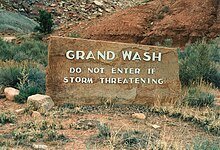Flash flood
As flash flood ( English flash flood ) is defined as a sudden flood, which usually followed by a sudden flood is connected.
One speaks of a flash flood or sudden flood, "[...] when, within six hours after a heavy rain event or a dike breach or after the breakthrough of another barrier (landslide, ice dam), huge masses of water suddenly burst over an area."
causes
The causes can be different: heavy rains , storms , dissolution of blockages in the normal course of the river , for example due to ice dams, or due to a dam break . Flash floods occur when there is more water than can be absorbed by the water system further down or by the ground. The draining water flows downwards at high speed and collects in lower lying areas. Flash floods most commonly occur after heavy rain in normally dry areas.
Hazard potential

However, the tidal waves can travel for kilometers from there. In doing so, they often pull objects with them, which additionally endanger people and property in the course of the flooding.
Flash floods are very dangerous because of their suddenness. Vehicles offer little to no protection against being washed away. Even a water level of 50 centimeters can pull an off-road vehicle with it. In some desert areas, dry and poorly absorbing river beds , so-called wadis , can swell into torrential currents within seconds , even after distant downpours, and pose a threat to hikers and vehicles.
Warnings about so-called flash floods are often found in the dry southwestern United States when roads or hiking trails cross dry river beds.
Historical examples
- Floods in the Pyrenees in 2013
- Flash flood in Toowoomba , Queensland , Australia , in early 2011
- Flash flood in the southern Thai province of Trang in 2007
- 2004 Boscastle flood disaster
- Weißeritz flood 2002
- Oder flood 1997
- Flash flood in Antelope Canyon 1997
- Canyon Lake Dam breach 1972
- Dam breach near Fischbeck during the storm on July 19, 1966
- Heinrich flood in southern Lower Saxony, North Rhine-Westphalia and northern Hesse on July 16, 1965
- Flood disaster in southern Lower Saxony during the storm on 27./28. August 1955
- Tangiwai railway accident in 1953
variants
- A stratified flood usually occurs in flat areas with little vegetation.
- A lahar is a volcanic mudslide.
- In 1996, 2004 and 2008 the US Department of the Interior created artificial flash floods in the Grand Canyon National Park to achieve renaturalization.
Metaphorical use of the term
The lexeme has been used in a figurative sense for a long time. For example, it served as a metaphor to criticize the multitude of Anglicisms in everyday German use.
literature
- Kevin Sene: Flash floods - forecasting and warning. Springer, Dordrecht 2013, ISBN 978-94-0079304-0 .
Web links
Individual evidence
- ↑ Ildikó Dobi Wantuch / Dr. Elena Kalmár, Hungarian Meteorological Service, Budapest in a translation by Elmar Uherek, Max Planck Institute for Chemistry Mainz, published in the Climate Encyclopedia ( Memento of the original from June 25, 2010 in the Internet Archive ) Info: The archive link was inserted automatically and not yet checked. Please check the original and archive link according to the instructions and then remove this notice.
- ^ Goldberg, V .; Bernhofer, Ch .: The flash flood event in the catchment of the river Weisseritz (eastern Erzgebirge, Saxony) from 12.-14. August 2002 - meteorological and hydrological reasons, damage assessment and disaster management . Ed .: EGS - AGU - EUG Joint Assembly. April 2003.
- ↑ dpa : Artificial flash flood in the Grand Canyon - environmentalists criticize (March 9, 2008)
- ^ Metalanguage discourses: Attitudes to Anglicisms and their scientific ... - Page 198 by Jürgen Spitzmüller - 2005

